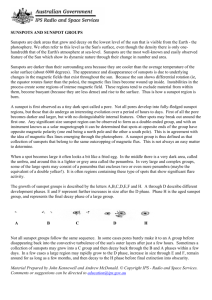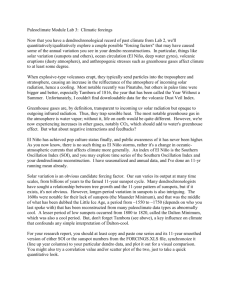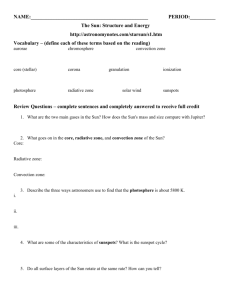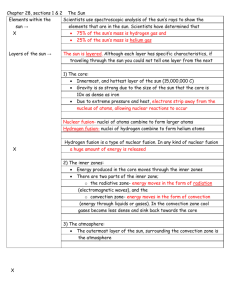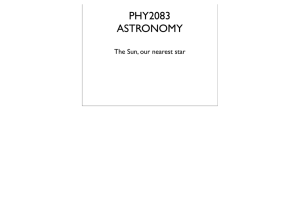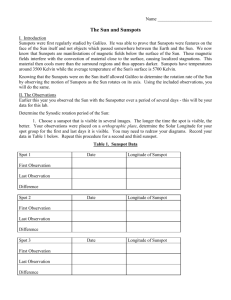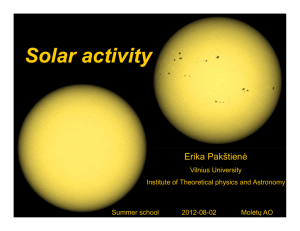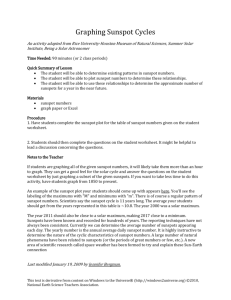Sunspots - Academic Program Pages at Evergreen
advertisement
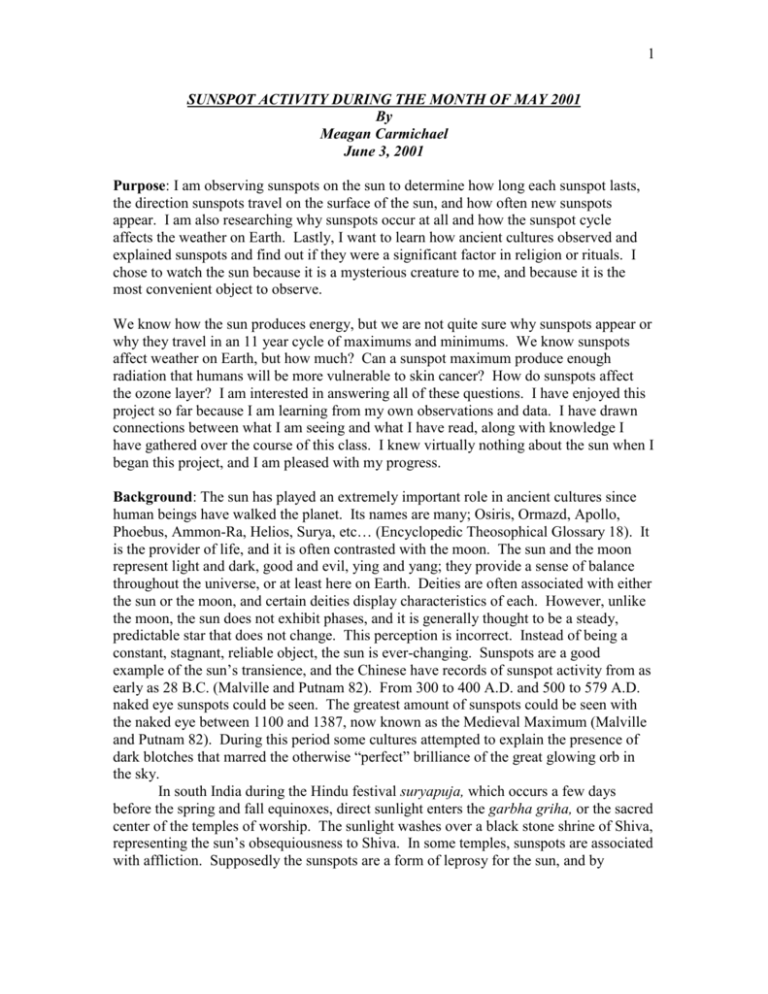
1 SUNSPOT ACTIVITY DURING THE MONTH OF MAY 2001 By Meagan Carmichael June 3, 2001 Purpose: I am observing sunspots on the sun to determine how long each sunspot lasts, the direction sunspots travel on the surface of the sun, and how often new sunspots appear. I am also researching why sunspots occur at all and how the sunspot cycle affects the weather on Earth. Lastly, I want to learn how ancient cultures observed and explained sunspots and find out if they were a significant factor in religion or rituals. I chose to watch the sun because it is a mysterious creature to me, and because it is the most convenient object to observe. We know how the sun produces energy, but we are not quite sure why sunspots appear or why they travel in an 11 year cycle of maximums and minimums. We know sunspots affect weather on Earth, but how much? Can a sunspot maximum produce enough radiation that humans will be more vulnerable to skin cancer? How do sunspots affect the ozone layer? I am interested in answering all of these questions. I have enjoyed this project so far because I am learning from my own observations and data. I have drawn connections between what I am seeing and what I have read, along with knowledge I have gathered over the course of this class. I knew virtually nothing about the sun when I began this project, and I am pleased with my progress. Background: The sun has played an extremely important role in ancient cultures since human beings have walked the planet. Its names are many; Osiris, Ormazd, Apollo, Phoebus, Ammon-Ra, Helios, Surya, etc… (Encyclopedic Theosophical Glossary 18). It is the provider of life, and it is often contrasted with the moon. The sun and the moon represent light and dark, good and evil, ying and yang; they provide a sense of balance throughout the universe, or at least here on Earth. Deities are often associated with either the sun or the moon, and certain deities display characteristics of each. However, unlike the moon, the sun does not exhibit phases, and it is generally thought to be a steady, predictable star that does not change. This perception is incorrect. Instead of being a constant, stagnant, reliable object, the sun is ever-changing. Sunspots are a good example of the sun’s transience, and the Chinese have records of sunspot activity from as early as 28 B.C. (Malville and Putnam 82). From 300 to 400 A.D. and 500 to 579 A.D. naked eye sunspots could be seen. The greatest amount of sunspots could be seen with the naked eye between 1100 and 1387, now known as the Medieval Maximum (Malville and Putnam 82). During this period some cultures attempted to explain the presence of dark blotches that marred the otherwise “perfect” brilliance of the great glowing orb in the sky. In south India during the Hindu festival suryapuja, which occurs a few days before the spring and fall equinoxes, direct sunlight enters the garbha griha, or the sacred center of the temples of worship. The sunlight washes over a black stone shrine of Shiva, representing the sun’s obsequiousness to Shiva. In some temples, sunspots are associated with affliction. Supposedly the sunspots are a form of leprosy for the sun, and by 2 prostrating himself before the mighty Shiva he is asking for a remedy (Malville and Putnam 82). In theosophy, sunspots are due to the rhythmic pulsations of a living organism that pumps life into the solar system. The 11 and 22-year sunspot cycle are due to the “contraction” of a solar heart. “Thus, there is a regular circulation of vital fluid throughout our system, of which the sun is at the heart—the same circulation of the blood of the human body—during the manvantaric solar period, or life; the sun contracting as rhythmically at every return of it, as the human heart does. Only, instead of performing the round in a second or so, it takes the solar blood ten of its years, and a whole year to pass through its auricles and ventricles before it washes the lungs and passes thence to the great veins and arteries of the system” (Blavatsky 121). Sunspots are considered part of the cycle of life, as everything in the solar system is connected and all of space is affected by sunspot activity. The well being of the entire solar system is controlled by the energy output of the sun. The appearance and disappearance of sunspots are direct evidence of the sun’s life force. The sun itself was worshipped by ancient cultures, but it represented something larger. The spiritual power that existed within the sun translated into the power that created all life. The sun’s light extends throughout the solar system, binding it into a single, living, breathing composition. The year 2000 began an impressive series of sunspots and high solar activity, so this was a good time to be alive and in an astronomy class at the same time. From class lectures, my own readings, and our guest speaker, Neal Hurlburt of Lockheed Martin, I learned sunspots are ultimately caused from the electromagnetic field of the sun. Sunspots are dark, often misshapen regions in the photosphere that are at much cooler temperatures than the surrounding areas. During my observations, I was surprised at how simple and undetailed they appeared through the Orion eight-inch telescope and through my binoculars. I expected to see spicules, granulation, and solar flares, but I couldn’t even see the umbra or the penumbra. The umbra is the fancy term given to the coolest part of a sunspot, which occurs at the center, and the penumbra is the part that surrounds the umbra. It is warmer than the umbra and appears a lighter color (Kaufmann and Freedman 430). The sunspots I saw looked like little dark specks, and congruous to what I read regarding the nature of sunspots, I often saw them in groups of two or three. According to one of my sources, the Encyclopedic Theosophical Glossary, Sun-Sz, sunspots are rarely observed above 45 degrees latitude, but I saw some. This reinforces the idea that I can’t take other people’s information as the absolute truth without investigating it for myself. Sunspots have magnetic fields, and one set will usually have a positive north magnetic field while the other set will have a strong negative south magnetic field (Morrison and Morrison 104). Most sunspots are not visible to the naked eye, even though the Chinese have references to sunspots from way back to 28 B.C. (Malville and Putnam 82), and in the ninth century in France many people have records of a visible spot that lasted for eight days (Morrison and Morrison 104). Johannes Kepler observed sunspots on a projected image of the sun in 1607, and he suggested two years later they 3 were from an infrequent transit of the planet Mercury silhouetted against the glowing orb, even though this was not the case, as we know today (Morrison and Morrison 104). Galileo first saw spots with a telescope in 1613, and he, along with Kepler, noted two different kinds of spots (Morrison and Morrison 104). I believe I have seen both kinds described by the two scholars, the first being the elusive small dots that appear and disappear within hours or days, and the second kind are large, imposing blotches that last for an entire rotation of the sun, or about four weeks. I have noted the same three major spots for about nine days before they disappeared, but that is the longest amount of time I have seen the same sunspot group. An average spot can measure several tens of thousands of kilometers across, or about the diameter of the Earth (sohowww.nascom.nasa.gov). I was able to see different sizes of spots, but I don’t think I could come up with accurate calculations of their real sizes because the spots may be too small. Sunspots are fairly short lived, with some lasting only a few hours and others lasting a few months (Kaufmann and Freedman 430). The color of the sunspot can be used to determine its temperature by using Wien’s law, even though I couldn’t discern different colors in my observations. The color of a blackbody depends on the wavelength at which it emits the most light, and the color of the sunspot is important because it tells us the temperature of the umbra can drop to 3700 Kelvin’s and the penumbra is approximately 5000 Kelvin’s; the rest of the photosphere is typically 5800 K (Kaufmann and Freedman 430). For solar physicists, this information indicates why sunspots occur at all. The area directly underneath a sunspot is much warmer than scientists expected it to be, and this is still an unexplained phenomenon, open for research (Neal Hurlburt, May 15, 2001 lecture at Evergreen State College). Sunspots appear so dark because the umbra of a sunspot emits only thirty percent as much light as an equal section of the photosphere without sunspots (www.science.nsfc.nasa.gov). The sun’s magnetic field has a 22- year cycle; the average number of sunspots varies within a period of 11 years, caused by sunspot minimum and maximum (Morrison and Morrison 18). Sunspot maximum, as its name suggests, is a period of an exceptionally large amount of sunspots, and sunspot minimum is a period of little or no sunspot activity. I am interested in the sunspot cycle because it affects Earth’s climate; at sunspot maximum the sun is .05 to .01 percent brighter than at the minimum, and the energy output of the sun is greater (Hanson 200). During sunspot maximum, temperatures on Earth can increase by as much as 1 to 2 degrees Celsius (Malville and Putnam 82). Relatively recent research published in the November 1999 issue of Sky and Telescope suggests an increase in ultraviolet radiation due to sunspot maximum may trigger a cycle of events in the ozone layer. According to the researcher Drew Shindell and his colleagues, during the months of December, January and February the sun’s light does not reach northern polar latitudes, and the stratosphere is only warmed at lower latitudes. The pressure of the upper atmosphere is raised, and the increase in ultraviolet radiation stimulates oxygen molecules to create more ozone. However, at the same time in the southern hemisphere higher temperatures speed up the chemical reactions that destroy ozone, canceling out the ozone amplification in the northern hemisphere. This concept fascinated me because nature seems so perfect sometimes. While ozone is being created it is also being destroyed, and the balance is maintained. Humans are the only 4 factor that disturbs the harmony of nature’s equation, and we destroy the ozone with harsh chemicals and pollution. The science and mystery of sunspots are explained in our books, and although there is no way to probe the interior of the sun, or even the surface for that matter, with observing instruments, there is strong evidence that sunspots are a byproduct of the sun’s magnetic field. We believe sunspots are places where the intense magnetic field of the sun pokes through the gases of the photosphere. The solar atmosphere is composed of ionized gas called plasma. In this medium, electrically charged ions and electrons can travel unhindered, but they are subject to the powerful magnetic fields of the sun (Hanson 77). The hot plasma that rises from the sun’s interior from convection is displaced by particularly strong areas of the magnetic field, and the plasma is essentially pushed away from the field, resulting in a distinct region of relatively cool gas (Kaufmann and Freedman 433). This cool, dark region is a sunspot. The direction of the sun’s rotation can be determined by observing sunspots. One sunspot group lasts about two months, and by watching one group over the course one month or so, I observed the sun rotates about once every four weeks. (More details about my observations can be found in the “Data and Results” section of this report). The equatorial regions of the sun rotate faster than the polar regions, a phenomenon called differential rotation (Hanson 254). This can also be observed by watching sunspots, but I was not able to observe this personally because there were not many sunspots to observe near the sun’s poles. Most of the spots I saw were slightly north of the equator, and as far as I can tell, no spots were consistently present during the whole four weeks. It takes about 25 days for a sunspot near the equator to travel once around the sun, but it takes 271/2 days for a sunspot 30 degrees north or south of the equator to travel the same distance. The rotation period near the poles can take 35 days (Kaufmann and Freedman 431). Equipment: I primarily used my 10x50 Minolta binoculars with a piece of cardboard attached to view sunspots during the four weeks of my observations. We built these to view sunspots for class. I cut two holes the size of my binocular lenses in a piece of cardboard and stuck my binoculars through the holes. I attached the binoculars to a tripod and aimed them at the sun. (Dawson I don’t know the page number). I set up my drawing pad behind the eyepieces and adjusted the position of the tripod until the image of the sun projected onto the pad. The sunspots looked like little dark specs inside a bright white circle on the paper. The first time I recorded sunspots I tried to trace the image directly onto my drawing pad, but the circle kept wavering and bouncing around, and it was nearly impossible to copy. The next day I decided to trace identical circles using a film canister lid for every day of my observations, and draw the sunspots freehand while looking at the projection of the sun. This method worked much better and I was able to get a more accurate recording. I also attempted to use the method for sun viewing mentioned on page 632-633 in The Audubon Society Field Guide to the Night Sky. This one doesn’t require any special equipment whatsoever. I cut a hole about an inch in diameter on one side of the lid of a shoebox. I taped a piece of aluminum foil over the hole, and then I poked a pencil through the center of the foil to let the sun’s light in. I taped a piece of white paper on the other side of the shoebox to project the sun’s image onto, and hopefully sunspots as well. 5 I aimed the end of the shoebox with the hole in it at the sun and a bright little circle appeared on the piece of white paper. The image was too small and sharp at first; it looked like a hot point of light. In an effort to correct this, I made the hole in the foil slightly larger, and the image got larger and more discernible. However, I could not see sunspots with this contraption. I think the sunspots visible now may be too small to project without some form of magnification, and this is why I wasn’t able to see them. While in Chaco Canyon in New Mexico, I also used the Orion eight-inch telescope with a sun filter to look at spot on the sun. I used a 25mm lens with a 48-power magnification and a 9mm lens with a 135-power magnification. I always started with the lowest power first so I could get the whole picture of the sun before looking at anything in detail. I was surprised at the lack of apparent magnification from the 9mm to the 25mm lens. I believe this is due to the Orion’s angular resolution, a quantity that measures how well minute details can be seen. Diffraction, the tendency of light waves to spread out when they are trapped in a small space, in this case the lens and mirror of a telescope, limit the angular resolution, along with the blurring effects of atmospheric turbulence (Kaufmann and Freedman 142-3). With the 9 mm lens, the Orion is approaching the limit of its angular resolution, and the sunspots I viewed with the 9mm were not much more detailed or magnified than they were in the 25mm. During one of my observations I could not see anything except a bright fuzzy light with the 9mm, even though the day before it worked fine. Observations: My observations began on Thursday, May 3, 2001 at Evergreen State College. In fact, everyone in the class got to see sunspots that day, because that was when we built the sunshades for our binoculars. My observations will continue until Friday of next week when the final draft is due. All of my sunspot recordings are between 1 p.m. and 7 p.m. I saw the number of spots jump from four to about nine in less than two days while we were in Chaco, and most of the spots were fairly small. Although the appearance and location of sunspots change slightly over the course of a day, for my intents and purposes here the movement is negligible. Although I have not tracked the same spots for more than six hours, my data reflects some spots are only visible for less than a 24 hour period, indicating if I did observe the surface of the sun for six continuous hours, I would have seen new spots form and disappear. I am watching sunspots to learn the direction they travel, how often new spots appear, how long one sunspot group lasts, and if I see any spots above 45 degrees north or south of the sun’s equator (which I have, contrary to what I have read regarding the usual location of spots). Even if my recordings are not 24 hours apart, I can still determine all of the information I am looking for. Variables and Controls: Some of the variables in my project include the time of day that I did my observations. As I said before, I was not able to take recordings every 24 hours because of my work schedule and life in general. However, if I had done my viewings at the same time everyday I would have better data for judging how much sunspots travel in a 24-hour period. Another variable is the type of equipment I used to view the sun. I used the Orion from May 7 through the 11, but the remainder of my observations were done with my binoculars. The view of sunspots with the telescope was upside down compared to the view in the binoculars. Over the course of my recordings, I noticed the 6 sunspots were definitely traveling left to right and toward the equator as viewed with my binoculars, but they were traveling in the opposite direction through the telescope. The telescope view was upside down. Controls included my method of recording sunspots. Consistency was important for this portion of my project; I had to pay attention to the relative distances of different sunspot groups and individual sunspots and record them carefully so I could get a clear view of sunspot travel. Calculations: Because of the brevity of this project, I did not use a complicated, scientific method of counting sunspots, like dividing the photosphere into individual regions designated my latitude and longitude and calculating the average number that appeared in each region over the period of a year and divide them by the circumference of the sun multiplied by the radius of a circle squared or anything (this calculation method is purely fictional and of my own creation to prove a point of the complication involved in counting sunspots and presenting the data the way that a scientific institution, like NASA, might). Instead, I merely drew how many spots I saw and recorded what they looked like. Data and Results: After watching sunspots for an entire month, I witnessed first hand their transience, direction of travel, rotation period, and “life span”. The graph on the following page shows how many sunspots were visible each day. The number of sunspots I saw each day ranged from three to twelve. The mode average of sunspots over this 30 -day interval was eight and ten- there were eight sunspots on seven different days and ten sunspots on seven different days. There was no median average because there is not an exact mid-point between three and twelve. I observed the most sunspots, twelve, on May 17. There were always at least three spots visible. The largest increase in the number of sunspots in a day occurred between May 19 and May 20, when they jumped from three to eight. The largest decrease in the number of sunspots in a day occurred between May 18 and 19, when they dropped from ten to three. Direction of sunspot travel was from left to right, and downward toward the equator. Sunspots often appeared in groups, and they emerged from the left side of the sun above and below the equator, and, depending on their size, were visible for a minimum of one day and a maximum of nine days. I watched one specific group of spots from May 20 until the 29, and this was the longest consecutive amount of time I watched one group. This group contained the largest spot I saw over the course of my investigations, and it included about five spots. I observed spots in both the northern and the southern hemispheres of the sun, with very little sunspot activity near the poles. I did not observe any concentration of sunspots in any specific location, except the top and bottom quarters of the sun had almost zero sunspot activity. I was not able to witness first-hand differential rotation because no spots were ever visible near the poles. 7 Actual Sunspot Recordings 8 9 30 29 28 27 26 25 24 23 22 21 20 19 18 17 16 15 14 13 12 11 10 9 8 7 6 5 4 3 2 1 0 Number of sunspots Day 1 2 3 4 5 6 7 8 9 10 11 12 13 14 15 16 17 18 19 20 21 22 23 24 25 26 27 28 29 30 Sunspot Number Number of sunspots during the month of May, 2001 Day Level of Uncertainty: I could have taken recordings 24 hours apart and I could have watched the sun for longer amounts of time to thoroughly understand the transience and unpredictability of sunspots, but I believe I achieved fairly accurate data for my intents and purposes. I would like to have used a high power telescope to get enhanced images of the sun and to see solar flares, spicules, and granulation, but this equipment was not available to me. I didn’t really have any problems with accurately recording the spots, I just drew what I saw and paid attention to where the sunspots were in relation to each other. I found it easier to track a group of spots as opposed to single spots. I could better determine the direction of travel (generally north south) when watching groups because they were larger and more conspicuous. Concepts/Relationships: I enjoyed this project because I used my own data to arrive at conclusions and make predictions. For example, while watching a series of three spots from May 5-10, I predicted they would no longer be visible after the 10 because I watched their travel from the 5-7, and estimated how long it would take them to get to the other side of the sun, where they eventually disappeared. My observations of their direction of travel matched what I predicted as well. The cosmologies portion of my report was especially interesting for me because cultures throughout history have seen the 10 same thing I was seeing, but they did not have the equipment or knowledge of the nature of the sun or its characteristics to explain dark, foreboding blotches on the otherwise perfect surface of the sun, so they came up with their own explanations for their presence. I try to imagine how I would explain sunspots if I lived a thousand years ago, and I would probably think they were tidings of disaster. This is the second scientific report I have created using my own data, and I learned from the mistakes I made on the first one. For instance, I did not wait until the last minute to do my observations for this report like I did last time. This was a valuable and fun learning experience. Works Cited Audubon Society Field Guide to the Night Sky. New York: Alfred A. Knopf, 1991. Blavatsky, H.P. New York: Crainridge Publishing, 1995. Encyclopedic Theosophical Glossary, Sun-Sz. http://www.theosociety.org Hanson, Jacob. The Sun: An Introduction. San Francisco: Porter Books, 1999. Kaufmann, William J III and Roger A. Freedman, eds. Universe: Fifth Edition. New York: Freedman and Company, 2000. Malville, J. Mckim and Claudia Putnam. Prehistoric Astronomy of the Southwest. Boulder: Johnson Books, 1993. Morrison, Phillip and Phyllis Morrison. “Sun-Stains”. Scientific American, March 2000, Vol. 282 Issue 3, p 104. Morrison, Phillip and Phyllis Morrison. “A Sunspot-Climate Link?” Sky and Telescope, November 1999, Vol. 98, Issue 5, p. 18. sohowww.nascom.nasa.gov 11
